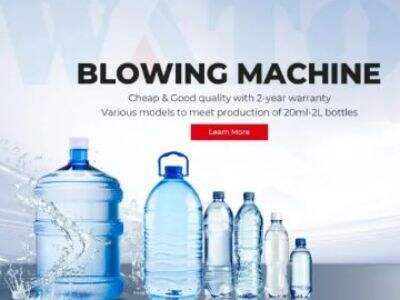If you know a little bit about how plastic bottles are made, you may realize how tricky that can be. A very important ingredient for making these bottles is known as a mold. A mold, or like a special container that shapes the plastic into the bottle you want.
Molds are very essential since they define both the quality and speed with which the bottles can be produced. Improving the efficiency of bottle production necessitates a great deal of careful thought about how to select and design a suitable mould.
The following are some of the most important considerations when it comes to molds:
Mold Material:-The material is highly important that a mold is made from. It determines the longevity of the mold and how well it would perform. These can be common materials such as aluminum, steel, or specialized plastics. All these materials come with their own pros and cons. Depending upon what you might need for your bottles, some materials might just be more apt for your needs than others.
Molds are designed that constitute a sort of synapse for the good quality bottles and contain how many spaces, often known as cavities, where bottles are found. The type of bottles with a specific bottle design and positions for cooling lines constitute good molds for fewer error-producing mistakes during production and hence faster production rate. A very well-crafted mold can be an assurance towards minimal waste produced in the bottling process as well as appropriate forming of the bottles.
Dying/Resin and Their Maintenance: Molds just like other machinery require proper care. That implies cleaning them occasionally, topping oil to be sure everything flows smoothly and replace worn parts to be brought into attention. Without managing the mold properly, it would break or perhaps produce low quality bottles that nobody would want to sell." Preparing regular maintenance is important.
In any of the following areas, this will give way to smoother, more efficient bottlemaking process.
Increase Bottle Production-Mold Design for Large-scale Production
Mass Production bottles depends considerably on good mold designs. A mould may significantly increase or even significantly slow up production, also limit the volume produced in a batch. Better designs in early phases of project production saves one more time as well as resources with good-quality bottles.
Here are a few of key design aspects which you need to keep in consideration:
Cavities: Increasing the number of cavities increases the number of bottles you will be able to make at the same time from a mold. However, if you increase this number, so does the trouble and cost required to make it. It has to be optimized between the numbers of pits in the mold versus the price with which you don't compromise to get the right production.
Cooling system: Cooling is an important part of bottle production and the design of the cooling system can greatly affect the speed at which the bottles can be produced. The cooling lines are positioned just so, allowing you to make more bottles faster. Cooling the molten polymer is important for ensuring the plastic solidifies correctly and takes the same shape as the bottles.
Parting Line – the parting line is the line at the intersection of the two halves of the mold. If the design is poor; it can create issues like excess plastic, known as flashing, framing a part. Thinking about the design of the bottles and the specific functional requirements of their shapes can help ensure the placement and design of the parting line is close to ideal.
Mold Longevity: Tips for Choosing the Right Materials
The great material must be chosen with the strength and durability in mind. A mold that wears out too quickly won't let you make many good bottles over the long run. You also want to choose materials that will withstand pressure.
The following are a few common mold making materials:
Aluminum: This is one of the most common materials used in making molds, and aluminum is light, easy to work and gives good quality level. Aluminum can also be used to speed up the cooling process of the mold, an important process in the manufacture of bottles. However, one must not forget that aluminum is not as strong or as durable as steel or a few other materials.
Steel Steel is also one of the most widely used materials in mold making because it is relatively strong and can easily withstand high temperatures and pressure without breaking. It is also more heavy than aluminum and more difficult to shape but is durable enough for numerous applications.
PTFE: PTFE is a plastic that is a rewritten version of their stickiness: they can be used to coat the molds themsleves to be made more not sticky, so less wear of the molds it is very usuable for increaseing the number of times used.
Automation and bottles: how these two fit together
Automation has revolutionized the way things are made in many industries, including bottle-making. Thanks to the use of machines, manufacturers can reap a lot of benefits that can enhance production.
Machines can allow you to:
Higher Productivity: Automated processes are faster and more consistent than manual processes. Having faster production speeds can lead to making more bottles during a given time-frame, which is obviously good for any business.
Enhanced Quality: Automation can help mitigate the potential for defects and inconsistencies in the final product. That's because machines can guarantee that each bottle is manufactured in the same way, and the end products appear and perform better.
Increased Efficiency: Automation can be helpful in the efficiency of making the product. Automation reduces manual labor and increases the speed of production, hence the cost for labor and time. This may save businesses in the long run and free more budget to be spent on other areas.
We also have some automated bottle-making machines in WATON. These are built to service both small startups and bottle-heavy manufacturers.
Fine-Tuning Design For Best Quality Of Bottles
It is of critical importance that every little detail in the mold and the whole manufacturing process be checked to ensure bottles are of the best quality ever. It can make all the difference between the quality and the end product.
Here is some of what you need to know:
Wall Thickness: The thickness of the walls of the bottle can create a difference in all aspects of weight of the bottles to how strong and stable they are. Getting that thickness just right is important for quality — which is to say ensuring the bottles aren't too heavy or too fragile.
Gate Location and Size MAX Full Servo High Speed Blowing Machine— A gate is the entry point through which plastic enters the mold. Which can determine the end product because location and size of the gate affects the flow of the plastic. By thoughtfully determining the location and dimension of the gate, you can prevent variation and increase uniformity in the bottles that you manufacture.
MAX Full Servo High Speed Blowing Machine : The molding temperature of the plastic injected into the mold will determine the time taken to make the bottles and the quality of the final product. The correct molding temperature can help you obtain the best quality and consistency out of your bottles.
Understanding such detail and others in the above-mentioned design aspects will help you ensure great bottles from your bottle making process, meeting your probiotic supplement needs.
To sum it all up, selection and design of molds is very important to the production of quality bottles. Consider the materials, design and automation; this allows you to elevate your entire process and succeed!" We at WATON are committed to supporting your endeavors in bottling, and look forward to collaborating with you on your next venture!

